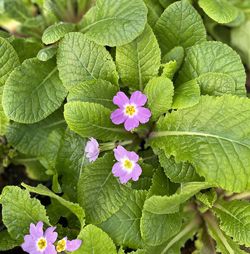Lobelia
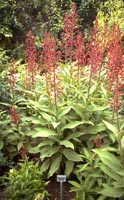
Cardinal Flower
In the dog days of August, just when the border is not looking so lively, this genus of colorful, stately selections rejuvenates the garden with spectacular leafy flowering spires, attracting crowds of eager hummingbirds. Perfect in meadow plantings, these sturdy herbaceous perennials appreciate a well drained site, a light winter mulching, rich, moist soils and partial shade in warm climates, except for Lobelia tupa and Lobelia laxiflora, which like it hot and on the dry side.
Lobelia cardinalis ‘Queen Victoria’ (P-2322)
Each $11.00
The seductive combination of radiant, tall scarlet-red spires grounded by sumptuous color-laden rosettes is this AGM-winner’s trademark. Shunning deer and rabbits, large, densely arranged 2-lipped blooms surmount strong, straight alternate-leafed dark stalks, while the lance-shaped foliage vaunts bronze, mocha, burgundy, damson and red shades. Coveted by gardeners, pollinators and floral designers alike, ‘Queen Victoria’ promises sizzling late summer vertical accents for hot-hued borders, woodland peripheries, cottage gardens and watersides. An adaptable multi-stemmed perennial, her gregarious habit relishes bright, evenly moist abodes with protection from hot afternoon sun plus a spring-time pinch to ensure comely compact growth.
Blooms mid July–September
Size: 3' 0" – 4' 0" high x 18" – 2' 0" wide.
Hardy to zone 4.
Lobelia ‘Grape Knee-Hi’ (P-1190)
Each $11.00
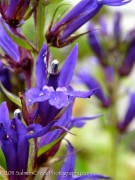
If you feel like Lobelia foliage occasionally looks a little unkept, you may be interested in this small-statured Dan Heim Lobelia cardinalis and Lobelia siphilitica hybrid. Garnished with tubular two-lipped sterile flowers, the dense long-lasting grape-purple spikes rise on sturdy upright stalks above a good-looking rosette of toothed dark green foliage. Awarded Top-Performing-Perennial status by the Massachusetts Horticultural Society, ‘Grape Knee-Hi’s trim lavishly-hued persona can hobnob with Hemerocallis ‘Corky’ and Geranium ‘Album’ in adequately moist niches. (pp#13,264)
Blooms July–August
Size: 18" – 2' 0" high x 12" – 18" wide.
Hardy to zone 6.
Each $11.00
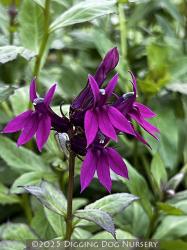
We have Thurman Maness to thank for this lovely cultivar, another cross between Lobelia cardinalis and Lobelia siphilitica. A dense tower of dusky plum flowers creates a pleasing blend of muted purples when planted with Verbena hastata and Astrantia ‘Lars’.
Blooms August–early October.
Size: 2-1/2' – 3' 0" high x 18" wide.
Hardy to zone 4.
Each $11.00
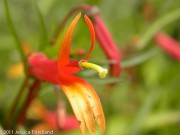
A lush-looking, bushy perennial capable of enduring considerable neglect, this impressive Lobelia plays host to festive bicolored blooms. Spreading by underground rhizomes, a close thicket of slender, yet sturdy, red-tinted stems strikingly set off narrow and lustrous, pointed green leaves that extend 2 to 4 in. Slim, 2 in. long red tubes are loosely clustered at shoot tips, while each bright-hued flower flares to reveal a sunny yellow throat.
Hailing from Arizona and Mexico, the Mexican Lobelia entices gardeners and hummingbirds alike with nectar-rich blossoms, can tolerate some shade, but looks its best in sunny, dry sites and has been reputed to possess anti-inflammatory alkaloids.
Blooms June–September.
Size: 2' 0" – 2-1/2' high x 2' 0" – 3' 0" wide.
Hardy to zone 8.
Lobelia siphilitica ‘White Candles’ (P-1237)
OUT OF PRODUCTION AT THIS TIME
Email me when this plant is available
Dressed in a crisp snowy white, the profusely flowered tapers of this Lobelia stand in sharp relief to its dark green foliage. A newly selected form of our U.S. native, ‘White Candles’s small, compact stature keeps its lift all season, lending a clean and classic look, especially when partnered with Geranium ‘Orion’.
Blooms July–August.
Size: 18" – 20" high x 18" wide.
Hardy to zone 5.
Many gardeners say the 2-lipped deep purple flowers of this tall cultivar reign supreme among Lobelias, and we whole-heartedly agree! Long-blooming, velvet-rich, terminal racemes crest upright stalwart stalks lined in lanky, semievergreen lance-like green foliage that’s infused with violet hues and lush panache. A mighty-fine addition to moist mixed borders, cottage gardens and pond peripheries, clump-forming ′Hadspen Purple′ can be planted in bold swaths amidst Phlox paniculata ‘Gzhel’ and Nepeta ‘Hill Grounds’, where it promotes vibrantly hued accents plus bee and butterfly enticements. (PBR)
Blooms July–September
Size: 2-1/2' – 3' 0" high x 18" wide.
Zone 6b.
Each $12.75

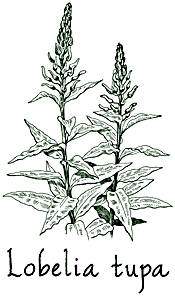
The lush tropical color scheme of this somewhat tender Chilean native is alluring. Cloaked in broad and pointed, felted pale green foliage, each soaring purple-tinged stem is crowned with a large, tapering raceme of warm brick-red blossoms. From the swollen base of each flower, a claw-like lower lip curls under and a tuft of gray stamens extends upward. A perennial of nearly monumental stature that likes it hot and on the dry side, Lobelia tupa can be associated with Melianthus, Muhlenbergia and Morina longifolia for a dynamic mélange of color and shape in the border.
Blooms July–October
Size: 6' 0" – 8' 0" high x 3' 0" – 4' 0" wide.
Hardy to zone 8.











